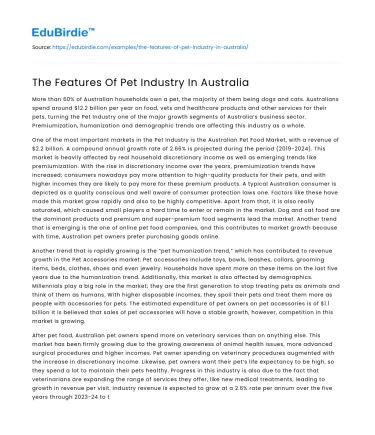More than 60% of Australian households own a pet, the majority of them being dogs and cats. Australians spend around $12.2 billion per year on food, vets and healthcare products and other services for their pets, turning the Pet Industry one of the major growth segments of Australia’s business sector. Premiumization, humanization and demographic trends are affecting this industry as a whole.
One of the most important markets in the Pet Industry is the Australian Pet Food Market, with a revenue of $2.2 billion. A compound annual growth rate of 2.66% is projected during the period (2019-2024). This market is heavily affected by real household discretionary income as well as emerging trends like premiumization. With the rise in discretionary income over the years, premiumization trends have increased; consumers nowadays pay more attention to high-quality products for their pets, and with higher incomes they are likely to pay more for these premium products. A typical Australian consumer is depicted as a quality conscious and well aware of consumer protection laws one. Factors like these have made this market grow rapidly and also to be highly competitive. Apart from that, it is also really saturated, which caused small players a hard time to enter or remain in the market. Dog and cat food are the dominant products and premium and super-premium food segments lead the market. Another trend that is emerging is the one of online pet food companies, and this contributes to market growth because with time, Australian pet owners prefer purchasing goods online.
Another trend that is rapidly growing is the “pet humanization trend,” which has contributed to revenue growth in the Pet Accessories market. Pet accessories include toys, bowls, leashes, collars, grooming items, beds, clothes, shoes and even jewelry. Households have spent more on these items on the last five years due to the humanization trend. Additionally, this market is also affected by demographics. Millennials play a big role in the market; they are the first generation to stop treating pets as animals and think of them as humans. With higher disposable incomes, they spoil their pets and treat them more as people with accessories for pets. The estimated expenditure of pet owners on pet accessories is of $1.1 billion It is believed that sales of pet accessories will have a stable growth, however, competition in this market is growing.
After pet food, Australian pet owners spend more on veterinary services than on anything else. This market has been firmly growing due to the growing awareness of animal health issues, more advanced surgical procedures and higher incomes. Pet owner spending on veterinary procedures augmented with the increase in discretionary income. Likewise, pet owners want their pet’s life expectancy to be high, so they spend a lot to maintain their pets healthy. Progress in this industry is also due to the fact that veterinarians are expanding the range of services they offer, like new medical treatments, leading to growth in revenue per visit. Industry revenue is expected to grow at a 2.6% rate per annum over the five years through 2023-24 to total $4 billion. Since Australia has a high pet ownership rate, many veterinary services are required, such as rehabilitation therapies, physiotherapy and acupuncture.
Pet healthcare products have become a vital expense for pet owners. These products help manage diseases, health related problems or illnesses. Some are flea treatments, tablets for parasites, and dietary supplements. This market became increasingly important as pets came to be such a significant part of peoples’ lives. Like the Veterinary services sector, this market attends the need of owners of keeping their pets in a healthy condition. Parasiticides for dogs and cats make up the majority of all healthcare products sold in Australia, and include treatments for both external parasites, like fleas, and internal parasites such as worms. It is easy for pets to get infested with parasites in Australia due to its environmental and climatic conditions. The risk of pets’ health is really high in the country, and this is why parasiticides from part of the greatest amount of pet healthcare products being sold.






 Stuck on your essay?
Stuck on your essay?

